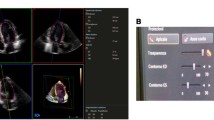Abstract
To determine the accuracy of visual analysis of left ventricular (LV) function in comparison with the accepted quantitative gold standard method, Cardiac Magnetic Resonance (CMR). Cine CMR imaging was performed at 1.5 T on 44 patients with a range of ejection fractions (EF, 5–80%). Clinicians (n = 18) were asked to visually assess EF after sequentially being shown cine images of a four chamber (horizontal long axis; HLA), two chamber (vertical long axis; VLA) and a short axis stack (SAS) and results were compared to a commercially available analysis package. There were strong correlations between visual and quantitative assessment. However, the EF was underestimated in all categories (by 8.4% for HLA, 8.4% for HLA + VLA and 7.9% for HLA + VLA + SAS, P all < 0.01) and particularly underestimated in mild LV impairment (17.4%, P < 0.01), less so for moderate (4.9%) and not for severe impairment (1%). Assessing more than one view of the heart improved visual assessment of LV, EF, however, clinicians underestimated EF by 8.4% on average, with particular inaccuracy in those with mild dysfunction. Given the important clinical information provided by LV assessment, quantitative analysis is recommended for accurate assessment.



Similar content being viewed by others
Abbreviations
- EF:
-
Ejection fraction
- HLA:
-
Horizontal long axis
- SA:
-
Short axis
- LV:
-
Left ventricle
- VLA:
-
Vertical long axis
- CMR:
-
Cardiac magnetic resonance
References
Bardy GH et al (2005) Amiodarone or an implantable cardioverter-defibrillator for congestive heart failure. N Engl J Med 352(3):225–237
Moss AJ et al (2002) Prophylactic implantation of a defibrillator in patients with myocardial infarction and reduced ejection fraction. N Engl J Med 346(12):877–883
Linde C et al (2002) Long-term benefits of biventricular pacing in congestive heart failure: results from the MUltisite STimulation in cardiomyopathy (MUSTIC) study. J Am Coll Cardiol 40(1):111–118
Corsia C et al (2004) Computerized quantification of left ventricular volumes on cardiac magnetic resonance images by level set method. Int Congr Ser 1268:1114–1119
Basilico FC et al (1981) Non-invasive measurement of left ventricular function in coronary artery disease. Comparison of first pass radionuclide ventriculography, M-mode echocardiography, and systolic time intervals. Br Heart J 45(4):369–375
Galasko GI et al (2001) A prospective comparison of echocardiographic wall motion score index and radionuclide ejection fraction in predicting outcome following acute myocardial infarction. Heart 86(3):271–276
Sievers B et al (2005) Visual estimation versus quantitative assessment of left ventricular ejection fraction: a comparison by cardiovascular magnetic resonance imaging. Am Heart J 150(4):737–742
Mueller X et al (1991) Subjective visual echocardiographic estimate of left ventricular ejection fraction as an alternative to conventional echocardiographic methods: comparison with contrast angiography. Clin Cardiol 14(11):898–902
Shih T, Lichtenberg R, Jacobs W (2003) Ejection fraction: subjective visual echocardiographic estimation versus radionuclide angiography. Echocardiography 20(3):225–230
Rider OJ et al (2009) Determinants of left ventricular mass in obesity; a cardiovascular magnetic resonance study. J Cardiovasc Magn Reson 11(1):9
Bland JM, Altman DG (1986) Statistical methods for assessing agreement between two methods of clinical measurement. Lancet 1(8476):307–310
Altman DG (2000) Diagnostic tests. In: Altman DG et al (eds) Statistics with confidence, British Medical Journal, London, UK
Hendel RC et al (2009) ACCF/ASNC/ACR/AHA/ASE/SCCT/SCMR/SNM 2009 appropriate use criteria for cardiac radionuclide imaging: a report of the American College of Cardiology Foundation appropriate use criteria task force, the American Society of Nuclear Cardiology, the American College of Radiology, the American Heart Association, the American Society of Echocardiography, the Society of Cardiovascular Computed Tomography, the Society for Cardiovascular Magnetic Resonance, and the Society of Nuclear Medicine: endorsed by the American College of Emergency Physicians. Circulation 119(22):e561–e587
Rich S et al (1982) Determination of left ventricular ejection fraction by visual estimation during real-time two-dimensional echocardiography. Am Heart J 104(3):603–606
Akinboboye O et al (1995) Visual estimation of ejection fraction by two-dimensional echocardiography: the learning curve. Clin Cardiol 18(12):726–729
Bansal S, Vacek JL, Ehler D (2002) Consistency of echocardiographic ejection fraction: variation and ‘drift’ by interpreter and practice site. Eur J Echocardiogr 3(1):44–46
Cook DJ (1990) Clinical assessment of central venous pressure in the critically ill. Am J Med Sci 299(3):175–178
Stamm RB et al (1982) Two-dimensional echocardiographic measurement of left ventricular ejection fraction: prospective analysis of what constitutes an adequate determination. Am Heart J 104(1):136–144
Acknowledgments
The British Heart Foundation supported this work.
Conflict of interest
There are no conflicts of interest to declare.
Author information
Authors and Affiliations
Corresponding author
Additional information
An erratum to this article can be found at http://dx.doi.org/10.1007/s10554-011-9864-8
Rights and permissions
About this article
Cite this article
Holloway, C.J., Edwards, L.M., Rider, O.J. et al. A comparison of visual and quantitative assessment of left ventricular ejection fraction by cardiac magnetic resonance. Int J Cardiovasc Imaging 27, 563–569 (2011). https://doi.org/10.1007/s10554-010-9706-0
Received:
Accepted:
Published:
Issue Date:
DOI: https://doi.org/10.1007/s10554-010-9706-0




